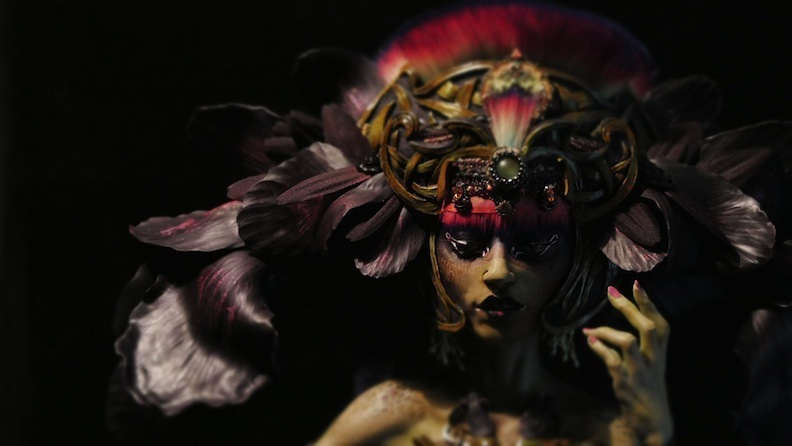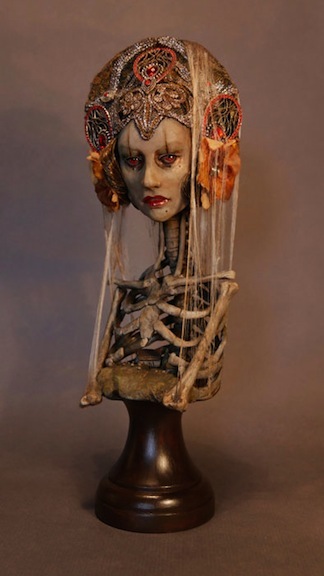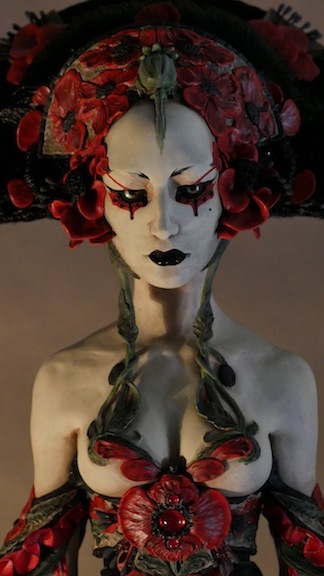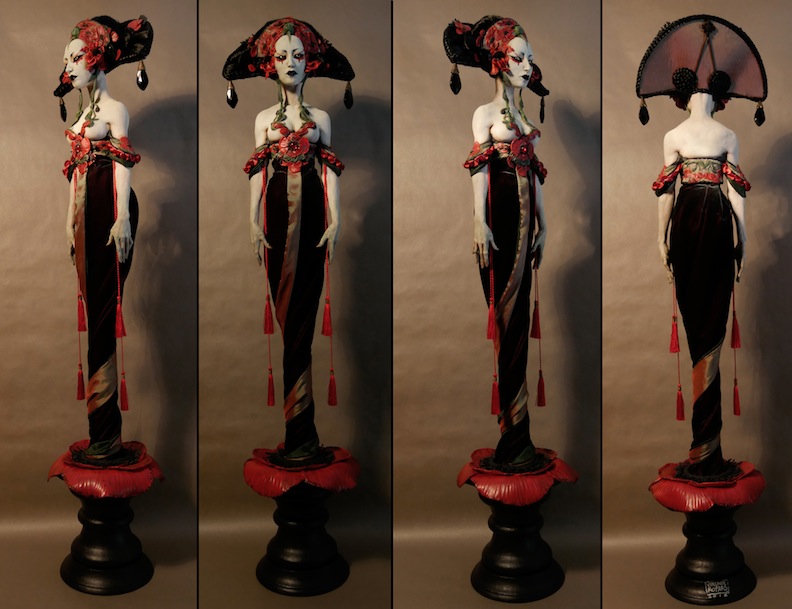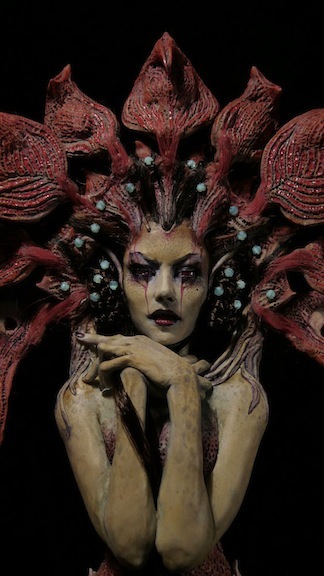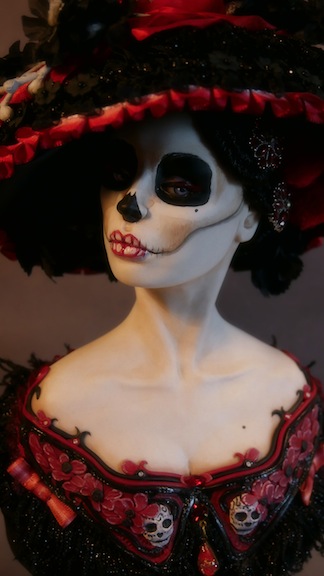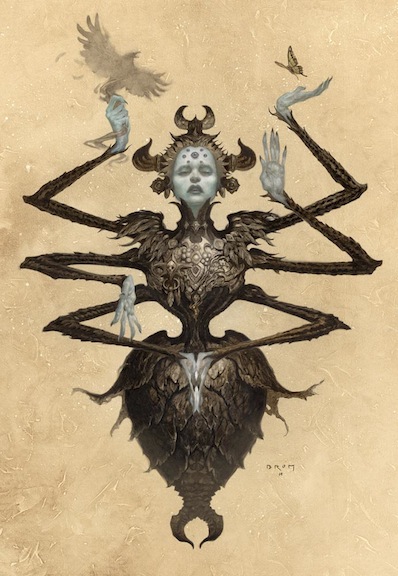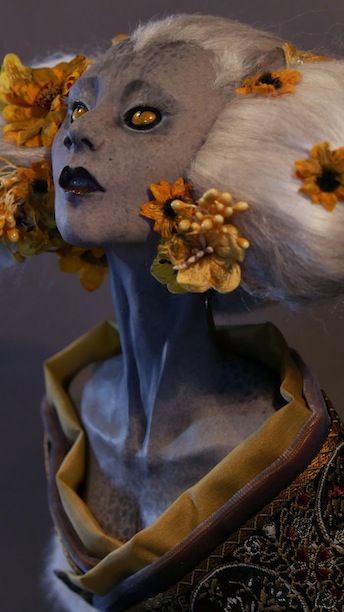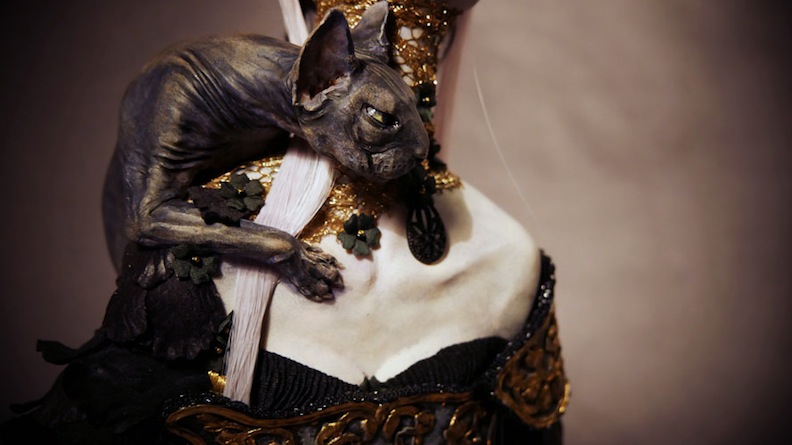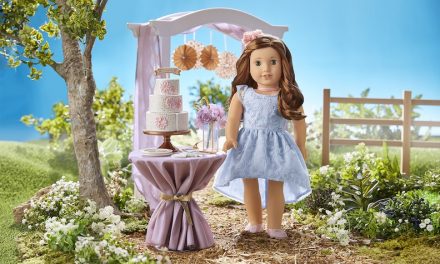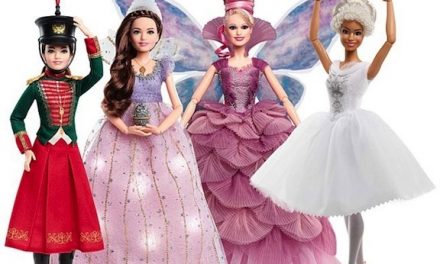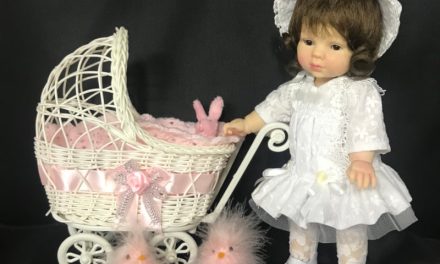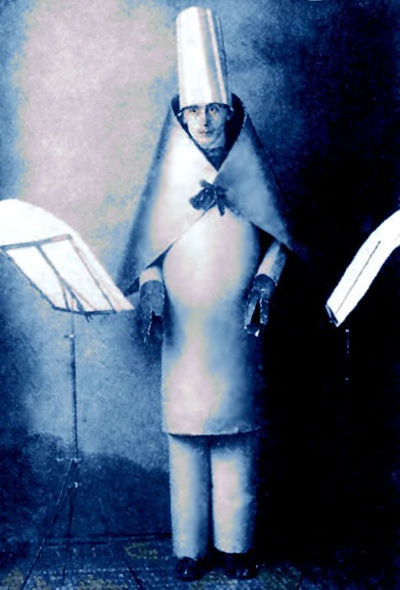At Halloween, thoughts stray to “evil,” or, at least, what passes for the E-word. For many of us, our first instinct is to imagine something scary-looking or horribly frightening. After all, something that equals “evil” must be terrifying to behold: picture scary scales, forked tongue, deadened eyes. (Apologies to all of our snake lovers out there if the description crawls too close to home. I don’t mean to bash herpetologists, folks who revel in amphibians and reptiles.) However, Virginie Ropars understands that a menacing character can also be hypnotic and beautiful, sultry and alluring. For this French artist, seduction and temptation go hand-in-hand with the shadowed side. It is up to the beholder to decide if her creations are formidable villains or forbidden dark angels.
Ropars is an artist who will bravely tackle the images that often cower in other people’s minds. Whereas many folks let their oddities and peculiarities lurk in their brains’ recesses, Ropars boldly invites hers out to cavort. She is not afraid to bring seductive and dangerous characters out into the light. Virginie Ropars understands that these so-called “femme fatales” or “queens of the night” are chilling yet desirable. Everyone craves the chance to be given a good scare.
In addition to her self-generated ideas, Virginie Ropars has enjoyed great success on a commissioned basis. “The ‘carte blanche’ sort of commissions are the best for me. This allows me to be as creative as I want and deliver the best I can. Most of the commissions start with simple ideas thrown on the table with the collector. It can be a color, a flower, a story, etc. The main thing is to trigger my imagination and let it flow. I cherish this way to work on things,” she has told me.
The talented Ms. Ropars began her professional sculpting career in November 2003. During this time, she has continued to fascinate and intrigue collectors the world over. Her figural art has been displayed at museums, galleries, and specially curated exhibitions around the globe. Virginie Ropars’s work cements the belief that unbridled passion, truth, and creativity are universal. Likewise, dangerous beauty, powerful temptation, and hidden secrets also strike a collective chord.
No matter the cultural origins of her fierce females, they all resonate with strength and confidence. Virginie Ropars will often find a motif and then build a mythic character around it. For instance, Ropars pursued a dramatic path when she decided to explore a floral theme. Her first flower creation was not the typical blushing rose or optimistic sunflower. “The first one is a full-sized Poppy-themed piece. I think she will be the first in a series of sculptures with single flower themes. I very much enjoyed working on a flower. I embrace its symbolism, mythology-related stories, and also what it evokes to me artistically,” she wrote.
Collectors who follow the articulate artist know that she does not disappoint with her work. Even though it is difficult to always be expected to unveil another eye-popping, jaw-dropping sculpture, Ropars has challenged herself for 16 years.
“People (including artists themselves) so much expect an artist to produce on a never-ending and exciting wave of creativity and projects. But that is not the reality of life for many of us on a daily basis. What you are, what you do, what you give, and what you get in the end may not be aligned. It may not align in your creative life, as it should,” she shared. Mindful to recharge and renew herself, Virginie Ropars embarked on an inward-facing journey. She desired to “re-align this core of things, and find myself again, and get a new resonance that is fruitful.”
It is an insight into the creative process, and Ropars is particularly forthright and truthful. She admits that it is “easy to lose yourself in this world. After years of feeding my creative beast and life, it ended up not resonating with myself as it did before.” Virginie Ropars was wise enough to step back and regroup.
Over the years, she has shared characters that are deeply private and also archetypal. She knows how to nourish the cravings and stoke the desires of her followers. The Acanthophis series ranks as one of Virginie Ropars’s most recognizable offerings. (Acanthophis is a genus of snakes. Often called “death adders,” they are among the world’s most venomous creatures.) Ropars fashions beautiful and haunting women under this label. “This series is sort of a collection of dangerous ladies,” she explained. One of them, Acanthophis V, had a surprising component.
“There is a bit of technical enhancement on this one, with moving parts,” she shared at the time. “The flower crown can be open or closed. It is something I wanted to make for ages to see if it worked, and it does.”
Yes, Virginie Ropars’s outpourings do fit nicely into the niche of Halloween, or its Mexican compatriot, the Day of the Dead. While many people fear walking on the wild side, except for those late October days and nights, Ropars doesn’t flinch. She is comfortable with mining macabre apparitions or less conventional notions of beauty. A powerful case in point: her collaboration with Brom.
Gerald Brom is a well-known American illustrator. He specializes in gothic art, fantasy images, and has contributed to comics, graphic novels, and role-playing games. Working under the name of Brom, he invited Ropars to make one of his drawings spring to three-dimensional life.
Choosing from his characters in the novel LOST GODS, she selected Yevabog. Using his drawing as a jumping-off point, Virginie Ropars created a spider goddess that is mesmerizing and menacing. Her creation weaves its own spell of surreal seduction and tingly terror.
Still, not all of her work comes from such a chilling creative pool. Some of her artistry has much more relatable and easily identifiable roots. For instance, she made her Moon figure because “I was waiting for my little Chartreux kitten to arrive home.” The full name of this sculpture is Waiting for the Moon. It takes on a tender backstory when you realize it was created during Ropars’s wait for her new cat companion. (Chartreux kittens are silvery blue or grayish blue, like the moon.)
A feline fancier, Virginie Ropars tackled her intriguing figure The Sphynx because of her pet preference. “I wanted to make a cat piece for a change,” she revealed. The finished creation is hypnotic and beautiful. “I used gold leaves for all the metallic-looking parts,” she instructed. “As usual, it is an original sculpture. Some of you sometimes ask me if I use molds in my work, but I don’t. It is all direct sculpting, including all the golden parts on this one. It has been made by hand, one by one.”
The world of Virginie Ropars’s ever-evolving and ever-engaging visions is a brilliant one. For more than 15 years, she has stunned and impressed, satisfied and surprised. Her work is akin to a Halloween spectacular: fanciful, frightening, exotic, ethereal, but still real. Better than Halloween, it is available to visit and experience year-round through her website (www.virginieropars.com) and her art shows. No trick, that is a true holiday treat.

